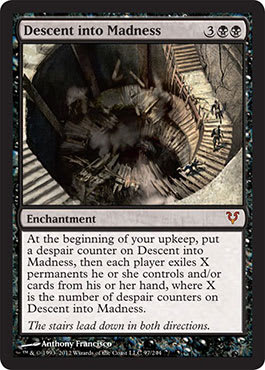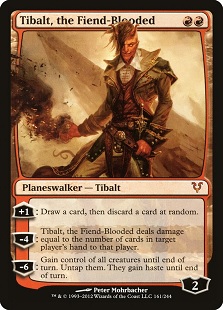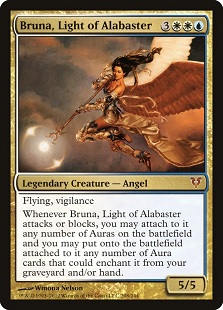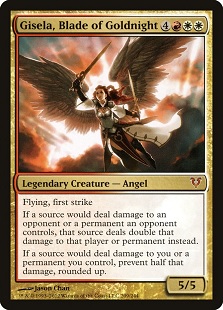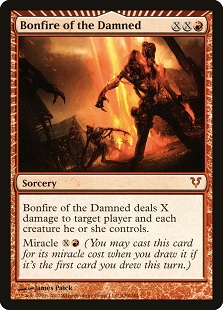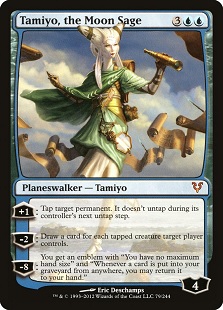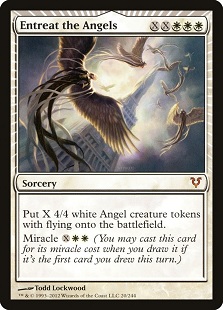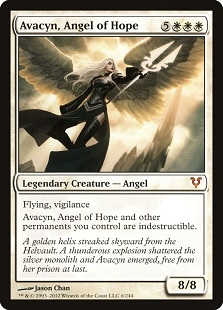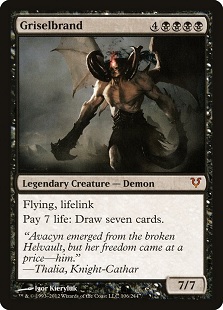We're now at the final set of the original Innistrad block with Avacyn Restored and what a strange set this was. Most players would be quick to jump to how awesome this set is for Commander, and they'd be right! Even at the time, it was a monumental success in that regard and offered a solid number of Constructed and Cube staples as well. Unfortunately, though, it's also remembered for having an extremely poor Limited space and those aforementioned playables being largely relegated to much higher rarities.
Thankfully, though, that means there's no shortage of awesome mythic rares for us to talk about this week on yet another mythic ranking article! There's fifteen pretty cool cards, many of which are tremendously iconic and influential to this day. Let's dive in and rank them all!
Number Fifteen
Descent into Madness is such an oddity. It's a card I see often in my collection and I go "I know it's bad, but I remember feeling like there's something to it?" Then I read the card again and remember that, no, it is in fact just bad. The card comes down extremely late and the impact of exiling cards is so slow and minimalistic that there is basically no impact at all where it matters. You get one card on turn six, two cards on turn seven, and so on. You can maybe do something here, but why would you want to? It's an interesting design that ultimately falls flat on its face in practice.
Number Fourteen
Malignus is boring, but it's an interesting design idea at its core. That being the question of what if you had a creature that was big enough to match half of your opponent's life total? How good would that be? In practice with Malignus, it's not all that good, though it was - and is - unique enough to have warranted the mythic rarity at the time. There's some really interesting play in that a damage doubler turns Malignus into a one-shot kill and that the card gets a bit better in multiplayer, but in reality, it's largely a pretty middle of the road card that has a bit of flashiness the first time you read it.
Number Thirteen
Oh, Tibalt. I bet most people would've expected to see him right at the very bottom of this list, but I think that's more the memes taking hold there. Make no mistake: Tibalt's first outing is not a great one at all, but it was and remains a commendable attempt. Remember that at this time, Planeswalkers were still extremely new and Wizards didn't know exactly where they could go, thus the thought experiment of "can you make a two-mana value planeswalker?"
These days, we have the hindsight of cards like Jace, Vryn's Prodigy and Wrenn and Six behind us, but at the time we didn't really have that frame of reference. I remember people seeing Tibalt and the two-mana cost to the card exciting players who wanted to try seeing what they could do with it. There was some interesting thought to him that made people want to try to make him work and for that reason alone the card deserves a fair amount of praise. Unfortunately, we're now twelve years removed from the release of Avacyn Restored and can firmly say that good lord, no, this card is awful.
Number Twelve
Of the three so-called Powerpuff Girls, Bruna stood out as the oddity a bit. Gisela was a clear frontrunner for Commander all-star and Sigarda was primed for competitive play (more on them soon) but Bruna felt somewhat underwhelming in the moment. When you thought of aura-based decks even back then, you'd usually find yourself looking to cards like Zur, the Enchanter or Uril, the Miststalker because of how they provided better utility and competitive play. By comparison, Bruna is merely fine, costing more mana to use and not providing as many colors to play with, and as such, she feels quite middle of the road. As more enchantments have come along over the years, her use has gone up a little bit, but not nearly to the degree as many other options available to players.
Number Eleven
For a bit now, players had gotten used to that one big and expensive Green spell that would provide some monumental effect if you could gain access to enough mana. Primal Surge was another strong contender in that category, and while it was cool to do once or twice, players quickly found that the appeal wore off fast. I've talked before about how despite being someone who loves Elfball decks in competitive Constructed formats, it's way less enjoyable due to how the experience is the same every time. Primal Surge provides a similar experience, wherein you can basically just flip your deck over and you run into the same play patterns each game. It's fun once or twice, but in the end, there can be - and is - too much of a good thing.
Number Ten
Temporal Mastery is the kind of card where you really just had to be there during preview season. With years of hindsight, we can recognize that the card was pretty cool, but largely ended up not being super useful. At the time, though, people saw the Miracle cost and acted like we were seeing the second coming of Time Walk thanks to utilizing it alongside library manipulation effects like Brainstorm. In the end, taking this line of play was more cute than anything, and while Temporal Mastery did see some play, it was far from the Time Walk players were expecting it to be.
Number Nine
At the time, Misthollow Griffin was a bit of an anomaly. It was both an absurdly dull card and yet a super interesting one as well. Where something like Malignus was dull and not very useful, this one ended up proving to be extremely playable in a specific type of deck. In this case, it was primarily used in Food Chain combo decks as a means to generate infinite mana to get in for a kill shot. The uses on this were very narrow, and we've seen the effect since in both Eternal Scourge and Squee, the Immortal, but it was still a far more interesting card than it appeared at first glance, which gave it far more staying power than anticipated soon after release.
Number Eight
Sigarda is the definition of workhorse cards. You never see her in large quantities, but when she shows up, she makes a big impact. It can be almost easy to write her off given how simple her abilities are as she's often just a French vanilla creature. In a format like Legacy or Commander where sacrifice effects are prevalent, she can really save your board's hide, and the fact that she has hexproof makes her difficult to deal with as well. Her uses were and are somewhat on the narrow side, but when she does eventually show up, she completely dominates the game.
Number Seven
Where Bruna was an oddball commander and Sigarda was more of a Constructed playable, Gisela was the card everyone wanted in their Command Zone. Seven mana is a pretty tall ask - especially for a Boros deck - but for the era that cost was fairly reasonable enough. Once Gisela ended up on the board, though, the whole table was suddenly in trouble. Barring hard removal spells like Doom Blade or wrath effects, Gisela is nigh impossible to take down, and utilizing cards like Darksteel Plate made that even harder. Not only is she difficult to topple, but so too are the rest of the creatures controlled by that player. She's an absolute dominant force at any Commander pod you play in even today and demands to be respected.
Number Six
In its heyday, Bonfire of the Damned was the absolute boogieman of Standard. You had no idea when it would show up, but you just knew it was an ever-present and looming threat in the background. No moment summed this up quite like the 2012 World Magic Cup where Team Chinese Taipei took out Team USA with a brutally lethal topdeck Bonfire of the Damned. The card could swing games dramatically at any given moment and had a truly polarizing impact on the game at the moment because of players' perception of the Miracle mechanic. Bonfire faded into relative obscurity following its rotation, but in the moment, it was the undisputed king of Standard.
Number Five
At the time of Tamiyo's reign, she was a Standard control player's all-star card. She simply does it all in shutting down opponents' ability to take actions, drawing you more cards once you slow things down, and if you can get her to ultimate then the ride simply doesn't end. You simply haven't lived until you've experienced a Tamiyo emblem from either side of the table, because it makes games truly get out of hand fast. She was spectacular at the time with Gideon Jura in particular, as he provided a way to tap creatures down and away from Tamiyo so then Tamiyo could draw more cards or work up to her ultimate. Her play has been down comparatively since, but even today you'd be hard pressed to not run away with games using her in Cube or in a well setup Commander deck.
Number Four
While Bonfire of the Damned exited Standard and largely left the collective minds of Magic players the world over, Entreat the Angels stuck around for a decent length of time. The card saw some moderate success in Standard and Block Constructed (remember that?), particularly following Pro Tour Avacyn Restored where Alexander Hayne won utilizing the card. From there it became a central namesake card alongside Terminus in the various Miracles decks of Legacy and had a minor showing in Modern as well. What the card lacked the bombastic nature of Bonfire, it had far more staying power and remains a showcase of the power of the Miracle mechanic.
Number Three
If you're someone who likes playing Magic that doesn't involve Standard or Pioneer, odds are good that at some point in your time with the game you've gotten Hoof'd. That is to say, your opponent has stuck the landing on a Craterhoof Behemoth and wiped out you as well as potentially the whole table if we're talking about Commander. Craterhoof has been an all-star finisher in so many decks for so many formats, it's almost nuts, and the design of this singular card has shown countless imitators since with few, if any, coming close to matching its might.
Number Two
The namesake card of the set - a character who had been hyped for months - finally shows up and wow, what a card! I personally don't like it much myself, as I think it's too expensive to get on the board and feels win-more once there, but even I'd be a fool to not commend the sheer bombasticness of this card. You don't play Avacyn because you're trying to win. You play Avacyn because you're trying to do something awesome and flashy as well as stop your opponents from destroying your stuff. Even if she alone doesn't take over your average game, there's a certain "wow" factor every time she shows up that only gets shown up by a single other card in the set.
Number One
Griselbrand is one of those legendarily game-defining - not simply format-defining - cards that shows up only once in a blue moon. For roughly a decade, Griselbrand was the absolute gold standard of decks looking to cheat creatures into play. Yes you play an Eldrazi titan like Emrakul, the Aeons Torn where you can and you'd rather Natural Order into a Craterhoof Behemoth for your Green Ramp strats. However, if you can think of a deck revolving around Reanimator, Sneak Attack, Through the Breach, and Show and Tell they all always ran Griselbrand where possible up until the printing of Atraxa, Grand Unifier. Griselbrand proved so strong he was even banned in Commander extremely swiftly after being printed. In a truly stacked set for mythics, Griselbrand is head and shoulders above the competition and that's an incredible feat all its own.
Paige Smith
Twitter: @TheMaverickGal
Twitch: twitch.tv/themaverickgirl
YouTube: TheMaverickGal
















